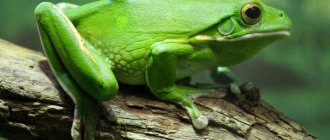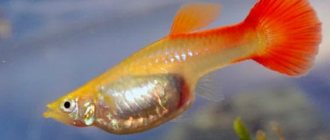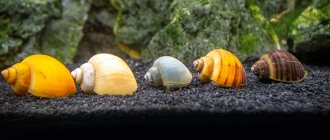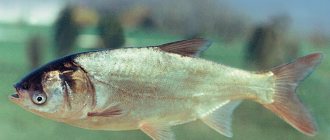What do chameleons eat in the wild?
Chameleons are considered predatory animals. They usually feed on various insects: dragonflies, grasshoppers, locusts and their larvae.
Sometimes they eat small lizards and rodents, and large reptiles even eat birds. Able to distinguish insects. Therefore, they do not eat food that can harm them - sting or poison them (wasp, bee, etc.).
Experts say that these animals eat everything they can grab with their tongue.
Under natural conditions, a chameleon's diet consists of various living creatures, which it can catch with its tongue.
Chameleons in nature obtain food by hunting. Hiding in the dense greenery, he waits for an insect to appear. At this moment, it rapidly throws out its tongue, which ends in a suction cup. Having grabbed the victim, he puts it in his mouth. The reptile selects only prey that matches the length of its body. In three seconds, a chameleon can catch four insects.
When at rest and in sleep, its extremely long tongue is curled up in its esophagus.
Exotic lizards feed daily or every other day. 4 feedings per week is enough for them. The young feed twice a day.
Vegetation is also included in the lizard's diet. Sometimes chameleons pluck leaves from trees or eat grass when they come down to the ground. They love to eat fruits and berries. Thirst is quenched with dew from leaves or twigs of plants.
In the wild, chameleons drink morning dew from the leaves of trees and bushes
Description
The Yemen chameleon is a fairly large lizard; males (which are always larger than females in all members of the family) can reach up to 60 cm, including the length of the tail. They have a much more variegated color.
Against the general bright green background of the body, 3 yellow longitudinal spots contrastingly stand out on the sides, alternating with bright yellow or orange and brown transverse stripes. The head has a flattened comb-like appendage, the height of which can reach 7-8 cm.
In females, this growth is not pronounced and usually represents a barely noticeable elevation. The tail is very strong, grasping, performs the function of a “fifth limb”, covered with green and yellow-brown alternating stripes and spots, until its very end.
When at rest, the tail is usually curled into a spiral. The body of chameleons is noticeably flattened laterally. The paws have an interesting structure: 4 fingers on them are sharply divided in pairs in such a way that 2 of them are opposed to the other two. This foot structure allows the lizard to rest securely on tree branches. The legs of males are more massive, especially the hind legs.
A well-known feature is the ability to change color quite quickly. Mainly used for camouflage on various surfaces.
In general, it is not the color itself that is transformed, but its overall tone, while the arrangement of spots and stripes remains constant. The modification of the color of chameleons is associated with the structure of their skin.
In the outer fibrous and deeper layer there are special branched marker cells - chromatophores, containing grains of various pigments - yellow, brown, black and red.
When the outgrowths of chromatophores are reduced, these grains are redistributed, and their largest accumulation appears in the central part of the cells and the lizard acquires the corresponding shade. When black pigment is concentrated in the upper part of the skin, it becomes dark in color.
The combination of both layers results in different color shades. The animal turns green as a result of the refraction of light rays in the surface layer of the skin containing guanine crystals.
What to feed a chameleon at home
Chameleons in captivity require a special diet, similar to their diet in nature.
The main role will be given to food of animal origin, and vegetables and fruits will be added to the main diet. The pigmentation of its skin and the activity of its lifestyle depend on how the reptile feeds.
The food must be given fresh and of high quality.
Food of animal origin
The main dish on the home chameleon's menu will be house crickets and cockroaches. Therefore, even before purchasing this exotic lizard, you need to purchase food at a pet store or decide on its supplier.
It's easy to grow your own crickets in covered plastic containers. Place the container on thermal film. Constantly maintain a suitable temperature of 33-35 oC.
Minuses
Chameleons' bodies do not have any odor, but when they wipe their jaws on tree branches, they begin to smell like rotten meat. This releases a smelly, waxy material from their mouth that helps attract prey. In addition, the animal's white excrement is somewhat similar in smell to human urine.
Health Issues: Care must be taken to ensure that the chameleon's habitat is in perfect condition. However, a number of health problems can still occur such as swelling, injury, respiratory infection, discharge, mouth infection, tongue tie problem and egg tying. Different types of chameleons prefer different temperature ranges
Therefore, care must be taken and constantly check with a thermometer whether the temperature is within the range. Otherwise, you need to spray a little water or light a few more bulbs
Typically, the temperature that most chameleons can withstand is between 10 and 22 degrees.
Chameleons require a special diet. Insects such as crickets, mealworms and waxworms need to be filled with nutrients first and then fed. Small mice without hair can only be fed to large chameleons. Plants: Mustard greens, collard greens, romaine lettuce, cabbage, turnip greens and dandelion greens need to be chopped to small sizes. Reptile supplements (calcium with vitamin D3 and multivitamins) come in powder form and should be sprinkled on food in optimal amounts to prevent vitamin A, calcium and vitamin D3 deficiencies. The water should be applied through a dripper or sprayer very slowly so that droplets form on the leaves where the chameleon can drink. The cost of a chameleon varies from species to species. On the Russian market, this number ranges from 10 to 70 thousand rubles, depending on the age and health of the lizard. It should be borne in mind that the cost of creating an ideal habitat and its subsequent maintenance is quite high. Cages for chameleons must be carefully designed, have the proper level of humidity, and plenty of greenery for a healthy and happy existence for the animal. From the point of view of temperature conservation, it is ideal if the cage is made of glass. As for sizes, the bigger the better. When purchasing a cage, owners must consider many different aspects that cannot be ignored: size, temperature, humidity, lighting, plants and rust resistance.
Feeding methods
One of the feeding methods is to plant food insects in a terrarium. It has disadvantages: insects quickly scatter and hide, making them difficult for the pet to reach.
The best way is to feed food using tweezers. You can do it with your hands, but a chameleon can bite quite painfully.
To feed the chameleon, you should purchase special tweezers from the pet store.
Feeding with tweezers is considered optimal because it allows you to keep your pet’s appetite under control.
Be careful not to let the chameleon grab the tweezers with its tongue. With the tip of the tweezers breaking off, he can break his teeth, which cannot be restored. If a reptile has attached itself to the tweezers, you should not pull them out: you can damage your pet’s tongue. Wait until the chameleon releases the tool on its own.
The pet supply department sells special tweezers with soft tips.
Another way to feed reptiles is through a feeder. You can make it yourself from an opaque cup of yogurt or sour cream. The inside of the container should be smeared with Vaseline or vegetable oil - it will be difficult for the insect to get out of it. The feeder is firmly fixed in the terrarium, positioned so that the pet can clearly see the food and it would be convenient for him to eat it.
You can use a feeder to feed your chameleon
Non-living insects should be removed from the terrarium immediately.
Plant food can be hung on driftwood located in the terrarium.
Breeding
They become sexually mature at the age of 9-12 months. If you place a suitable partner with them, then it is quite possible to get offspring.
Usually, a planted female causes activity and mating games in the male, but you need to make sure that there is no aggression.
If the female is ready, she will allow the male to court her and mate. They can mate several times until the color changes to dark, indicating that she is pregnant.
The dark color of the female is a signal to the male that he should not touch her. And she becomes very aggressive at this time.
After about a month, the female will begin to look for a place where she will lay eggs. She sinks to the bottom of the terrarium and looks for a place to burrow.
As soon as you notice this, add a container of moist vermiculite or fiber to the terrarium.
The mixture should allow the female to dig a hole without crumbling. Moreover, the container should be large enough, at least 30 by 30 cm. The female can lay up to 85 eggs.
They will incubate at 27-28 degrees for 5 to 10 months. You can transfer the eggs to an incubator, where it will be easier to monitor them and remove unfertilized ones.
How often to feed a chameleon
Young animals need to be fed 2 times every day, adults - 1 time every 2 days. It is a good idea to feed your pets according to a schedule - give food at the same hours.
An adult chameleon eats from 1 to 10 crickets per day, young ones - 1-3. The optimal dosage can be determined by observing your pet for 2-3 days. A well-fed reptile refuses to eat, so it is almost impossible to overfeed a chameleon.
An adult chameleon eats up to 10 crickets a day
These exotic reptiles always look not very well-fed. But this does not mean at all that they are hungry or sick. Chameleons eat very little in the wild.
Description, size, life expectancy
Adult males reach from 45 to 60 cm, females are smaller, about 35 cm, but with a fuller body. Both the female and the male have a crest on their head that grows up to 6 cm.
Young chameleons are green and develop stripes as they mature. Females can change color during pregnancy, both sexes during stress.
Coloring can vary depending on different conditions, for example, social status.
The experiment showed that young Yemen chameleons raised alone were paler and darker in color than those raised together.
Healthy and kept in good conditions live from 6 to 8 years, with females being smaller, from 4 to 6 years. This difference is explained by the fact that females carry eggs (even without being fertilized, like chickens), and this takes a lot of energy and wears them out.
Features of the drinking regime
Chameleons can go without food for 3-7 days. But after 3 days of lack of water, dehydration occurs in the reptile’s body. They become lethargic and do not eat anything. Every time they eat, they feel sick, their eyes and cheeks are sunken, and the bones and vertebrae on their paws and tail become clearly visible.
Chameleons are susceptible to dehydration
If you notice signs of dehydration, contact your veterinarian immediately.
Dehydration is very dangerous for lizards. Therefore, an important condition is maintaining humidity in the terrarium and the constant presence of filtered water in the drinking bowl.
To humidify the air, install a waterfall or fountain with a water filter. The filter must be changed regularly to avoid the accumulation of pathological microflora in it, which leads to diseases of the reptile. It is recommended to regularly (up to 4 times a day) spray objects and vegetation, as well as the walls of the terrarium and the reptile itself with a spray bottle. Humidity should be regularly monitored using a hygrometer. 60-90% would be optimal.
To monitor the humidity level in the terrarium, you should install a hygrometer.
A convenient way to give your lizard water is to use a drip drinker from a standard medical dropper. Secure it in the terrarium (or outside), adjust the speed of drops falling. Place the tip of the homemade drinking bowl in a place that is easily accessible to your pet. Place a container below to catch the dripping water.
The surest way to give your lizard something to drink is with a small syringe or pipette. This way, your pet can always receive the necessary portion of fresh water:
- Take a syringe with water.
- Use your index finger to slightly press down on your pet's chin.
- Drop water from a syringe into the small gap formed in the reptile's mouth.
- Let your pet swallow the drop.
You can give your chameleon something to drink using a small syringe.
You can add a little freshly squeezed fruit juice. The same method can be used to easily dose liquid vitamin and mineral supplements.
Under no circumstances should you give juices from stores. Sugar and additives in them are extremely harmful to the health of the reptile.
It is important to understand that a chameleon’s diet must be balanced and according to a schedule. Then he will definitely delight you with his appetite and appearance.
Are you a chameleon owner? How do you feed and water your pet? Share your experience in the comments.
Communication
Most lizards are accustomed to living alone. Therefore, chameleons must be handled very carefully.
You should not make sudden movements, especially in the first days of life in your home. The animal needs to get used to the environment, get used to it, and remember its owners.
Tips for keeping a chameleon
- Chameleons, like any other animal, love cleanliness. Therefore, the terrarium must be kept clean. Once a week it is necessary to carry out wet cleaning
. - At the same time, you should not remove the animal; it should get used to you. Pets are very nervous, so you should not create stressful situations.
- Do not forget that the terrarium is intended for only one individual. If you put two animals in one terrarium, one of them will feel uncomfortable.
- If you are adopting an animal for the first time, it is better to choose a male.
Lifestyle
All chameleons are lazy and phlegmatic; they spend almost their entire lives sitting motionless on tree branches, waiting for potential prey, without changing their original position for hours or even days. However, in case of danger they can run very fast.
The only exception to their phlegmatic lifestyle is the mating season, when these lizards begin to show at least some activity. We will describe the very interesting mating traditions of chameleons in more detail later in the article.
Nutrition
What does a chameleon eat? Like many others
lizards, chameleons are predators. Their diet is based on various large insects (crickets, butterflies, beetles), other small lizards, and sometimes even snakes. Large chameleons can hunt birds, rodents and other small animals. However, some chameleons will not mind eating leaves and fruits; they especially love tangerines and oranges; they can eat cherries, cherries and grapes.
Read on for more details on chameleon hunting methods.
Habitats
There are eighty species of chameleon south of the Sahara, which share tropical Africa and Madagascar. Four or five species inhabit India, Arabia, Southeast Asia and the Mediterranean coast of Africa. Individual specimens are found in southern Spain.
Long ago, during the heyday of the Secondary Era of reptiles, chameleons as large as cows may have existed. But those glorious days have passed, and today the fickle animal is content with an average size of 20-30 centimeters. As in many cases, extremes remain in Madagascar: there are eighty-centimeter giants and extravagant dwarfs who can easily fit four people in a matchbox.
Arrangement of the terrarium
To ensure that your pet is in a good mood, does not experience stress, or gets sick, it needs to be placed in a spacious vertical terrarium
Much attention should be paid to ventilation - it should be flowing
Chameleons are prone to respiratory diseases. The air should not be allowed to stagnate.
There should be enough space per adult. For a male - 45x45x90 cm, for a female - 45x45x60 cm (L x W x H). But if you have the opportunity to expand it, it will only be better.
In nature, reptiles spend a lot of time in trees, so snags with many branches are installed inside the terrarium, and vines are suspended. Chameleons love to camouflage and experience stress in open areas. At home, this needs to be compensated by increasing the amount of foliage on the branches, albeit artificial.
It is best to use woody soil as a substrate. It holds moisture well and does not mold.
Types, photos and names
Zoologists count 193 species of chameleons, which are grouped into 11 genera. We will describe the most interesting of them.
Panther chameleon
It is one of the most brightly colored representatives. While young individuals have gray skin, older panther chameleons can take on a variety of colors and shades, from turquoise, green to red. The average body length is 52 cm. Males are usually larger than females and have a brighter color. It got its name due to a series of oval spots that are located on its sides. It lives on the island of Madagascar and neighboring islands. Can live at home as an exotic pet.
Yemen chameleon
A fairly large chameleon, up to 60 cm long. Like panther chameleons, males are larger and more brightly colored. A characteristic feature of this type of chameleon is its high crest, located on the head; it grows up to 7-8 cm. In its color, attention is attracted by 3 yellow spots on the sides, each of which is decorated with an orange and brown stripe. Unlike other species, male Yemen chameleons are more aggressive, sometimes life-or-death clashes occur between them. They live in the mountains of Yemen and Saudi Arabia.
Comb chameleon
This species received its name due to the characteristic fan-shaped comb located on the back. On his head he has something like a helmet, decorated with bright blue scales. It has a gray, brown or black color, while females are green. The body length of the comb chameleon is 20-25 cm. It lives in West Africa.
Jackson's Chameleon
This bright green chameleon can change its color very quickly, turning blue or yellow. A true master of camouflage. It differs from other chameleons by the presence of three brown horns located on the nose and between the eyes. The body length of this species is 30 cm. It lives in the tropical forests of East Africa.
Desert chameleon
Found exclusively in the desert regions of Angola and Namibia, this chameleon is perfectly adapted to life in arid environments. It changes its colors not only to camouflage itself from enemies, but also to regulate body temperature. Body length is 16 cm.
Common chameleon
The most common representative of the extensive chameleon family. It lives over a wide geographical range: from the forests of Syria, India and Arabia to South Africa. It is up to 30 cm in length. Skin color can be mottled or solid, it is usually bright green, but can turn yellow and bright red (depending on need)
Giant chameleon
The giant chameleon living on the island of Madagascar is notable for the fact that it is the largest chameleon in the world. The length of its body reaches 68 cm. It has a brown body, strewn with yellow, green and red spots.
general information
This exotic animal is called an unprincipled person who changes his views very easily depending on the situation. Chekhov added fame to this image. Perhaps, because of his famous story, our people have a somewhat negative chameleons
Unlike human chameleons, the chameleon animal is completely harmless, at least for people. The main feature of the chameleon is its unique camouflage - the ability to quickly change color under the influence of the color of the environment, light, and temperature. It was this amazing property of the animal that the masters of the pen used. By changing the color of its skin, the chameleon becomes invisible to predators. Such disguise is his only way of protection.
The oldest known chameleon was found in Europe (the find is approximately 26 million years old). However, chameleons are probably much older than this (there are finds dating back more than 100 million years). Fossils have also been found in Africa and Asia, and it is believed that chameleons were once more widespread than they are today. They may have their origins in Madagascar, which today is home to almost half of all known species of this family, then dispersed to other lands.










